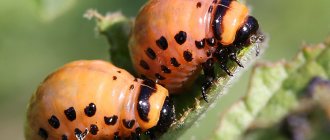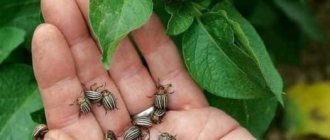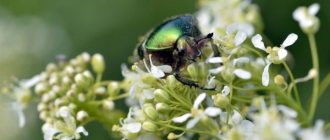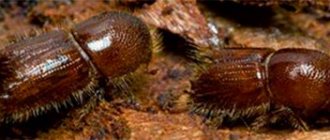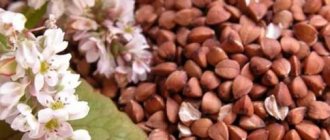How to deal with the main pests of lilies
Many gardeners encounter problems such as pests when growing lilies. Great harm is caused by beetle larvae, potato cutworms, onion beetles, etc. Various methods are used to control pests, but the most popular are: soaking bulbs before planting in insecticides or potassium permanganate, prevention during flowering, timely removal of weeds, dried flowers and leaves.
Lily fly
The lily fly is easily visible on lilies due to its red color. She lays eggs from April to September. The fly and its larvae feed on the leaves, flowers and seed pods of lilies, causing enormous damage to the plant. To combat the lily fly, synthetic pyrethroids are used (Fastek, Karate, Decis, Antizhuk). The treatment will need to be repeated after two weeks.
Potato scoop
The potato cutworm is very dangerous for lilies. The caterpillar is red in color and its eggs are found on wild weeds and grasses. It can move onto lilies from weeds that grow nearby. The caterpillar eats the young shoots from the inside, the flower breaks off and withers. It can be controlled by timely removal of weeds.
Onion mite
The mite, which is only 1 mm in size, causes irreparable damage to lily bulbs. It eats the scales of the onion, causing it to rot. The lily's leaves turn yellow and die, and it stops growing. Gradually, the mite spreads to other bulbs through the soil, and thus all bulbous plants become infected. The pest can be controlled by digging up and destroying infected bulbs. For prevention, before planting, the bulbs should be kept in a solution of potassium permanganate or Karbofos and sprinkled with chalk.
Important! If your garden plot has been infected with a mite, do not grow bulbous plants for 3-4 years until it disappears completely
Aphids and spider mites
Aphids are a very small but dangerous pest. Aphids on lilies greatly weaken the plant by eating it and infecting it with viral infections. You can get rid of it by spraying the lily with insecticides. Spider mites drink sap from plants, causing the leaves to turn yellow, become covered with cobwebs and dry out. A lily can become infected with mites from fruit trees or berry bushes that grow nearby. To prevent and control the pest, you should spray not only lilies, but also nearby shrubs and trees.
The most dangerous enemy of lilies is the squeak beetle. But the most dangerous thing is its larvae. They are very gluttonous. The beetle and its larvae eat lily leaves and carry various viruses. The squeak beetle is resistant to various chemicals, so it is best to destroy it manually. Be careful: if you drop a beetle, it will pretend to be dead, turning over on its back, and since its abdomen is black, it is difficult to find it on the ground.
Chemical poison for annoying pests
Summer residents who do not want to use dangerous products cover flowers with chemicals that are practically harmless in nature. These pesticides paralyze the nerve endings of young insects. However, this remedy does not work on adult beetles.
In addition, you can use products that have a repellent odor. In this case, the beetles simply will not be able to stay on the plant and devour it.
It is recommended to use these preparations to protect flowers, since the products destroy or harm only pests.
AllaAuthor of the article
Did you like the article?
Share with your friends:
Asiatic lilies: diseases
Lilies belonging to Asian hybrids are the most unpretentious, and therefore the most common. They can be grown almost all over the world, even in Alaska.
In cold climates, the flower stalks of the plant are cut at ground level so that they do not rise above the snow cover. However, Asiatic lilies are more susceptible to some fungal and viral diseases than others.
Causes
A fungal disease known as botrys affects flowers in cold weather with high humidity levels. Therefore, when choosing a site for planting, you should choose a place that is well ventilated.
Rotting of the bottom of the bulb is also caused by a fungus and is called fusarium. The reason for its occurrence is stagnation of water as a result of poor drainage or lack thereof, the use of fresh manure as fertilizer, and drying out of the earthen coma.
Quite often, lilies are infected with the variegation virus, which is transmitted to them from tulips that previously grew on the site. Therefore, it is not recommended to plant lily bulbs after other bulbs. Viral diseases can also be caused by insect pests. Regular control of them will protect your plants from viruses. Remember that well-groomed plants are much more resistant to various diseases.
Symptoms
How to recognize the onset of a disease in order to provide the plant with the necessary help in a timely manner? To do this, you should know the symptoms of diseases. For example, when affected by gray mold, signs of the disease appear on the leaves in the form of brown spots, which merge into entire foci, moving to the buds (Figure 8).
Figure 8. Disease manifestations in Asiatic lilies
It is important to know that viral diseases are much more dangerous than fungal diseases, because they often occur hidden, and when the symptoms become visible, it is impossible to save the plant. This is how, for example, the variegation virus occurs
Therefore, if you notice features and color of a flower or the shape of a stem that are uncharacteristic for a plant, you should immediately get rid of it so as not to infect the entire flower garden.
Treatment
The best way to combat Asiatic lily diseases is prevention. So, to prevent botrys disease, it is recommended to water the seedlings with a solution of copper sulfate, ammonia and soda ash.
If preventive measures have not been taken, then to treat gray mold, plants are sprayed with Bordeaux mixture, and in case of severe damage, with foundationazole or phytosporin every 2 weeks. In case of fusarium disease, it is necessary to dig up the bulbs, wash them well and soak them in the foundation solution for 30 minutes.
Remember that it is impossible to cure viral diseases, therefore, when viral lesions are detected, your main task is to remove and destroy the infected plant as soon as possible in order to save the entire flower garden.
Description of the signs of lily diseases and how to treat them
The fungal diseases that most often affect these flowers include:
Botrytis (spotting)
This disease, dangerous for such plants, is also called gray rot, since a grayish coating can be seen on all parts of the diseased lily in cool and humid weather. On infected flowers, round or oval spots of orange-brown shades first appear. The first signs of botrytis appear on the lowest leaves, and then they spread to the rest. Gradually, the spots merge into one, and the leaves turn brown and die. Flowers affected by botrytis lose their buds.
Prevention and treatment
We remove the diseased parts and burn them. At the beginning of spring, sprinkle the flower beds at the dacha with wood ash (300 g/sq.m.). When the first symptoms of the disease appear, we spray the flowers with 1.5% Bordeaux mixture or 0.2% foundationazole. To prevent leaf spotting, spray them immediately after emergence. We carry out another 2-3 single treatment of lilies with an interval of 10 days. For spraying we use preparations such as Oksikhom, HOM.
Fusarium
The fungus attacks the bulb, starting from its bottom. It turns brown and falls apart. The leaves turn yellow and the plant develops worse. Over time, the flower affected by fusarium dies.
Prevention
Before planting lily bulbs in the ground, treat them with 0.2% foundationazole. In the fall, we treat the soil at the dacha with 3% metham (carbation). The consumption of this product is 5 l/1 sq. m. To prevent disease, we make sure that there is no increased soil moisture. We also do not allow the introduction of poorly rotted manure and excessive amounts of nitrogen-containing fertilizers, which contribute to the development of this disease. We regularly mulch and drain the soil.
Rust
Small colorless spots with clusters of orange-colored spores appear on the leaves, then they turn yellow. In diseased specimens, the above-ground parts of the plant quickly dry out.
Spray treatment
Treat infected lilies with 1% Bordeaux mixture. In the fall, we burn the remains of plants.
Dangerous viral diseases include:
Mosaic
Small oblong spots or streaks of light shades appear on the leaves and stems. The disease affects the entire above-ground part of lilies. In this case, the plant takes on an ugly appearance. The disease is most often transmitted by aphids and mites.
Control measure
Sick specimens are burned along with the bulbs.
Herbal infusions as a method of combating red beetles
The complex for protecting lily plantings from red beetles consists of observing crop rotation, as well as regular destruction of weeds by the roots, and spraying plants in problem areas during the period when the larvae feed on herbal infusions. This is wormwood and tall larkspur. To prepare the solutions, you will need the tops and leaves of wormwood, harvested during the flowering period, and the entire tall larkspur plant. It is better to cut it at the beginning of flowering.
Wormwood solution: fill the bucket completely with chopped fresh wormwood grass or 800g. dried. Fill with water at room temperature. Leave for a day, then simmer over low heat for half an hour. Before use, dilute the solution using one part of the broth and one part of water.
Solution for spraying from larkspur: place a kilogram of crushed potion in a bucket, add cool water, leave to infuse. On the third day, strain. The solution is ready, you can start spraying.
In order for the solution to cling to the leaves, it is recommended to add one of the surfactants to it: soap solution, the cheapest shampoo or a little PVA glue.
To ensure that the red onion beetle avoids lilies and other green foods it likes, spraying the plants with these preparations should be carried out several times at intervals of one week.
Distribution and behavior of toy soldiers
Ladybugs are distributed throughout the world. They live on all continents of the world except Antarctica. Ladybugs inhabit open spaces with herbaceous vegetation - gardens, meadows, forest edges, steppes, and less often - forests.
The peculiarity of these beetles is that when threatened, they secrete a rather sharp-smelling, poisonous yellowish liquid that scares away enemies. Only a few species of these beetles are harmful to crops.
The ladybug is not always a red beetle with black dots (the photo demonstrates this). Some of the varieties have a yellow outfit with black dots, others are black with red dots.
Beetles live in temperate climate zones in Eurasia, and are also found in North Africa and North America. The bug can be seen at almost any time of the year, except winter. There are especially many of them in the spring, when the sun warms up well. They sit in small groups in open areas.
The composition of their diet includes fruits that have fallen to the ground, seeds, and plant juice. Their main feature is that they sometimes eat their relatives when they live in large colonies.
At the end of autumn, beetles with red backs and black dots lie down for the winter under fallen leaves, under the bark of trees and in other places sheltered from the wind and severe frosts. With the onset of winter, soldiers enter the adult insect stage. Nature has endowed them with an unpleasant odor to repel natural enemies.
Pests of lilies
One of the most common pests of lilies is the greenhouse aphid - inconspicuous green sucking insects that en masse around the plant, sucking out the juices from it and leading to the death of the plant.
The lily fly lays eggs in unopened buds, and the emerging larvae eat them from the inside, distorting the shape of the flower.
The larvae of the squeak beetle are very voracious, eating leaves entirely or leaving roughly gnawed edges covered with mucus.
Significant damage to plants is caused by the larvae of the beetle and click beetle (wireworm), no less voracious are the larvae of the elegant red lily beetle or the onion rattle, after which sometimes only stems without leaves are left.
Root bulb mites stick to the bottoms of the bulbs during storage, and the spider mite stretches the web between the leaves, on which, if you look closely, you can see traces of insect punctures.
Lily pests are destroyed with insecticides: actellik, inta-vir, and the bulbs are treated with karbofos.
During storage, the bulbs become prey for mouse-like rodents and moles, which are destroyed using various pesticides.
The efforts spent on fighting diseases and pests of lilies will not be in vain - beautiful flowers will reward you with amazing, perfect forms that deliver aesthetic pleasure from the exquisite miracle that has unfolded.
Garden lily is a plant that was previously considered a royal flower, and today has become a favorite decoration for many flower beds. Thanks to the work of breeders, the exquisite and noble lily acquired various shades, making daylilies a real “highlight” of the garden plot. Flower growers lovingly care for a beautiful flower and are very worried if the lilies turn yellow. Why do lilies turn yellow?
Healthy lily leaves are always green
Iron deficiency
The yellowness of the leaves, increasing every day, while the veins remain green, indicates that the flower lacks iron obtained from the soil.
What to do to make up for this deficiency? In this case, prepare fertilizer for the plant. Its basis is settled water (3 l), to which iron sulfate (8 g) and citric acid (2 tsp) are added. After thoroughly mixing the aqueous solution, it is used for leaf treatment, as well as for foliar watering.
Nitrogen deficiency
A weakened, pale plant with yellow leaves, which also grows slowly, is a sign of nitrogen deficiency.
In this case, you can use any fertilizer containing nitrogen. You should be careful when applying fertilizer, since excess nitrogen consumption will also not benefit the plant. Strict adherence to the instructions for using the fertilizer will help provide the lily with nitrogen without causing harm.
Proper watering
Garden lily is a plant that requires careful attention to watering. The flower, tropical in origin, is still sensitive to sufficient soil moisture. With long breaks in watering, the lily leaves begin to turn yellow and the flower dries out. So, the soil is dry, the lilies are turning yellow, what should I do? Under no circumstances should you overdo it with watering or overwater! Excessive watering, stagnation of moisture with poor soil drainage is undesirable. Root rot, which appears due to waterlogging, also leads to yellowing of the lily leaf.
The correct method would be systematic watering, which is carried out as the soil dries; in hot, dry weather, the lily will be grateful if it is watered every evening.
Description of enemy #1
The lily beetle got its name because of its irresistible love for these beautiful flowers, but it does not disdain lilies of the valley and hazel grouse. With the arrival of spring, he makes his way into the garden, where with amazing agility he destroys foliage, flowering buds and even bulbs.
If the enemy is not destroyed immediately, then when it lays larvae, the situation will become much more complicated.
This beetle, quite cute in appearance, has the following characteristic features:
- Large eyes;
- Narrow chest;
- Wide belly.
- It has long legs and antennae that are black in color;
- The chitinous elytra are bright and shiny, similar in color to a fire engine;
- Beetle larvae, similar to caterpillars, are thick and fleshy. Most often they are yellow-brown, sometimes orange.
Fire beetle larvae could be destroyed by birds, but... These cunning creatures have invented protection. They take refuge completely in their own feces. As a result, the larvae become indistinguishable from excrement to birds and are of no interest as a food source.
Enemy #2
The red onion beetle resembles a ladybug. It spends the winter buried in the ground, and with the arrival of warmth, by the beginning of May, it emerges from the shelter.
This is a rather large insect, the length of which reaches 7 centimeters. His legs are long, red with black speckles. And above the black belly there are oval, hard, chitinous elytra of a fiery red color. The picture is completed by a long black mustache that extends to half the body.
The larvae of this insect are light gray in color, with black dots on both sides, and the same black legs and head. This worm's back is covered in feces and nasty mucus as camouflage.
These insects and their larvae will happily feed on onions and potatoes, and can also spoil lilies and hazel grouse.
They can destroy all greens, including the stem and bulbs. These creatures bite off a piece from each bud, and as a result, the blooming flower will be disfigured.
How do these beetles reproduce?
These insects begin to mate with the arrival of warmer weather. They can be seen sitting on top of each other on a favorite lily or hazel grouse bush. In the same place where they feed - among foliage and flowers. This is where they lay their larvae - on the underside of a leaf or on the trunk of a plant. The laying process is completed by the beginning of August.
A female beetle can produce up to 450 eggs, which give birth to three generations of beetles. After a week, the eggs hatch into larvae. But it’s difficult to see them because they hang on the inside of the leaf plates.
These voracious creatures destroy leaves one by one, having an excellent appetite. Thanks to this they grow very quickly. After just two weeks, pupation occurs, and after three weeks, the red beauty appears.
This moment becomes a new round of devouring lilies, after which the plant may not recover - instead of a beautiful bush, a bare skeleton remains.
With the arrival of cold autumn days, the beetles go to winter, burrowing into the soil, so that at the beginning of spring they repeat the whole cycle all over again.
Onion rattle
The second enemy of lilies is the onion rattle or red onion beetle, which resembles a ladybug. It goes into the soil for the winter and appears on the surface at the end of April or early May. An adult beetle of this species is an elongated oval-shaped individual, the size of which is no more than 7-8 cm in length. The abdomen is black, the elytra are orange-red. The legs are red with black spots, the black antennae are shorter than half the body length.
The larva of the onion rattle has a dirty white color, with black dots on the sides. The head and legs are black. The back side of the larva is covered with unpleasant mucus and excrement.
The onion borer damages onions, tobacco, potatoes, hazel grouse, all types of lilies and other plants. Both adult beetles and their larvae cause damage to green spaces by devouring leaves, green seed pods, stems and bulbs. This insidious insect manages to pinch off a tiny piece from many buds in a short time, but this already serves as a reason for the fact that the blossoming flower will be completely spoiled.
Lily pests - how to fight?
The most common pests of lilies are:
Lily beetle (Liiioceris lilii)
- a clearly visible insect of bright scarlet color; the head, limbs and antennae are black. If you catch a beetle and squeeze it with your fingers, it makes a characteristic cracking noise. Large orange-red larvae are covered with black secretions and have an unkempt appearance. They lay eggs from April to September. On plants at the same time you can find fresh clutches, larvae of different ages and adult beetles. The beetle and its larva completely eat up the leaves and can damage buds, seed pods, stems and stem bulbs.
Control measures: hand collection is quite effective when there are few beetles in the garden. If there are a lot of lilies or the beetle has multiplied greatly, treatment is carried out with synthetic pyrethroids (for example, Decis, Fastak, Regent, Karate, Aktara) or drugs less toxic to humans (Bombardir, Konfidor or Antizhuk). Plants are sprayed during the period of mass appearance of the beetle, as well as after larvae are detected on the leaves. It is better to repeat the treatment after 7-14 days.
Aphids (Aphidoidea)
usually settles on young shoots and leaves, on buds and green boxes.
Control measures: spraying with Karbofos (7.5 g per 1 liter of water), Actellik (1-1.5 ml per 1 liter of water).
Khrushchi, or May bugs
(Melolontha melolontha), namely their larvae - white, thick, sickle-shaped, with a yellowish head - gnaw roots, gnaw through bulbs, making passages in them.
Fall armyworm
(Agrotis segetum) - its large (up to 4 cm) dirty green caterpillar lives and winters in the soil, nibbles on bulbs and stems.
Measures to combat beetleworm and fall armyworm are similar: they use the drug Bazudin and other diazinon-based products.
Bulbous tripe
(Liothrips vaneeckei) has a narrow body of dark brown color, up to 2 mm long. Lives between the scales of bulbs of various types of lilies, as well as on onions. It sucks out cell sap, causing the appearance of yellow spots on the bulbs, as well as colorless dots or a kind of “silver” streaking on the leaves. This reduces the decorative value of plants, and damaged areas can become a place for pathogens to enter.
Control measures: drug Actofit, 0.2% ka (Aversectin), soaking the bulbs for 30 minutes in a 1% solution.
In recent years, flower growers have increasingly used plant substances with fungicidal and insecticidal properties. To cleanse the soil of mushrooms, nasturtium, marigolds, eschscholzia, and dimorphotheca are planted in a place cleared of lilies. Their volatile emissions are toxic to soil fungi and repel nematodes. Infusions and decoctions of onion, garlic, black pepper, aloe, St. John's wort, yarrow, hemlock, aconite, wormwood, dandelion, and orange peel have insecticidal properties.
You can read more about the varieties of lilies and about the conditions for growing lilies
Lilies in a summer cottage are not uncommon. Some grow ordinary Daurian lilies of a beautiful red color, while others grow them in festive decorations. And everything would be fine, but with imported planting material they brought to Russia the worst pest of these beautiful flowers - the red lily beetle (lily rattle, fire beetle).
It is quite easy to detect the lily beetle on plants due to its bright red color, sharp sound when danger threatens, and size (about 1 cm). The cunning creature, sensing danger (a human step, an approaching animal), immediately makes a sound similar to a rattle, falls to the ground with its belly up, merging in color with the ground.
How to identify a pest?
As soon as the first rattle beetles are noticed on flowers in the spring, the gardener should immediately begin to fight them. It is not difficult to recognize this pest - the beetle is brightly colored and quite large in size (0.6-1.5 cm).
There are about 1,500 species in the Leaf Beetle family, but only two of them cause harm to lily crops:
- Lilioceris lilii, or lily rattle. The body, head and paws of the parasite are completely black, the elytra are bright red. Size from 6 to 9 mm.
- Lilioceris merdigera, or onion rattle (bulbous). This beetle is slightly larger than the lily rattle, and its head and part of the legs, like the elytra, are colored red with an orange tint.
Read also: How to freeze mint for the winter at home
People call them squeakers or firemen and are often confused with each other. The period of active reproduction of red beetles is from May to the first half of July.
Adults do not cause significant damage to plants (although they feed on the greenery of lilies). But each female rattler is capable of laying up to 450 orange eggs per season. The clutches look unpleasant, like small lumps of gray translucent mucus, and are located on the lower part of the leaves, so it is difficult to see and pick them out manually.
Rattlers got their name from the chirping sounds they make in times of danger.
Pests of lilies and their control
It so happens that insects love to feast on all varieties of lilies. Today there are 15 main pests that affect lilies. In this case, one must take into account the fact that they can not only eat all fragments of the plant, but also carry various diseases.
The most dangerous pests for lilies are presented below.
Red beetles on lilies
Red beetles on lilies
There are red bugs on lilies, how to get rid of them? This problem is quite common and occurs if a flower lover does not follow the rules of crop rotation in the flowerbed and does not carry out preventive irrigation of the bushes.
Has alternative popular names:
- squeak beetle,
- bulbous rattle,
- lily beetle.
It is quite easy to find due to its bright red color; the larvae are pink and covered with a special protective mucus that inhibits plants.
The main symptoms of damage are the wilting of the plant; it is very easy to see insects and their larvae on the aboveground part of the crop.
Spider mite
A pest that drinks all the juices from a plant, causing it to wither.
Important! A terrible feature of the insect is that the eggs of the species are able to live in the soil for more than 5 years and are highly resistant to many drugs. The main symptoms of the lesion are the gradual drying of the bush, the leaves curl, and the buds fall off.
If you look closely, you can see threads of cobwebs, many white eggs and adults on the leaves
The main symptoms of the lesion are the gradual drying of the bush, the leaves curl, and the buds fall off. If you look closely, you can see threads of cobwebs, many white eggs and adults on the leaves.
Spider mite
Caterpillars on lilies
This is a real problem that can lead to the death of the plant.
The insect lives in the soil and overwinters there. When the bush is damaged, it begins to literally eat flowering shoots and bulbs.
The greatest damage is caused during the rainy period and in areas where a large amount of weeds grow, since butterflies lay eggs exclusively on weeds.
Rodents
How to protect lilies from rodents in the country? These questions concern everyone without exception, since rodents severely damage the plant. As a rule, after such damage it simply dies.
How to plant lilies without being eaten by mice? There is one simple but proven method - before planting the bulb, treat it with diluted Vishnevsky ointment. By the way, this treatment also protects the plant not only from rodents, but also from some insects and diseases.
Mice
Other pests
Less common “lovers” of lilies:
- The lily fly attacks uncolored lily buds. The defeat will become more obvious when the entire inside of the bud is eaten, and the fly quietly pupates in the soil.
- The Colorado potato beetle is an insect that lays its larvae on the back of the leaf blade; this happens from June to August. In the near future, the eggs hatch into young individuals that infect all fragments of the aboveground part of the lily.
- Slugs. Black slugs appeared on the lily - the picture, of course, is not a pleasant one. Moreover, the plant soon begins to fade before our eyes. Mollusks become active in rainy and humid weather and affect all above-ground parts of the plant. Getting rid of them is not so easy, since fungicides and insecticides are effective against insects, but not against molluscs.
- Thrips are dangerous because they suck all the juices out of crops. Silver spots always form in their habitat (this is perhaps one of the most obvious signs of damage). Next, insects penetrate the buds, as a result, the latter, before they have time to open, become discolored and fall off. They overwinter in lily bulbs; if the air temperature does not drop below +10 degrees, they remain active. Affected bulbs are usually covered with a red dense crust.
Methods for controlling lily pests will be discussed below.
Enemy number 1 for lilies
Voracious red bugs, which brazenly devour leaves on lilies and do not disdain even flower petals, are found everywhere in Europe. In our country they became known at the very beginning of the nineties of the last century.
This pest loves to eat lilies most of all, although it does not ignore plants such as lily of the valley and hazel grouse. Already at the very beginning of spring it can be seen in plantings, where it begins to devour leaves, flowers and bulbs. If you don’t get rid of it right away, then after the larvae appear, it will be very difficult to fight the beetle.
Adult red lily beetles have a characteristic appearance:
- Quite large eyes;
- Quite narrowed chest;
- Wide belly.
Body color: the area in front of the back and the elytra are scarlet, sometimes bright red, the surface of the latter is shiny with depressions. Long limbs and black antennae. The larvae of rattlers resemble caterpillars, equally wingless with a thick, long body. Their color is yellow, brown, orange.
Birds are potential enemies for the larvae. So they came up with an interesting way of protecting themselves by covering the body with their excrement. As a result, feathered enemies mistake the young individual for their feces and do not pay any attention to them.
Fighting the lily beetle
Greetings, dear readers!
At first glance, it seems that there is little threat to such garden beauties as lilies. In reality, they also have an enemy. It's called the lily beetle
or lily rattle. The insect received its last name due to the fact that when threatened, it makes a sharp sound reminiscent of a rattle.
The range of this insect includes Eurasia, but it has practically never been found in Russia and neighboring countries before. The situation changed dramatically when several years ago, along with imported planting material, the lily beetle found its way into domestic flower beds.
Biological features of the lily beetle
The body of the imago reaches 1 cm in length. Externally, the beetle is very attractive. Its shimmering red wings make it a real beauty. The insect flies beautifully.
A few individuals in the garden are not capable of causing much harm to daylilies. But if the beetle population reaches a significant size, the flowers begin to suffer.
Lily beetles can lay eggs twice during the summer season. The clutch is a grey-brown slime on the underside of lily leaves. Two weeks after the eggs are laid, small larvae are born. Their body is very delicate, painted in a bright orange or pinkish color. The larvae have a high appetite and cause significant damage to the leaves and flowers of lilies. In its appearance and gluttony, the lily beetle at this stage of development is similar to the Colorado potato beetle.
After a month of increased feeding, the larvae go deeper into the soil and turn into pupae. After another three weeks, young beetles emerge on the surface of the earth, which are not yet sexually mature individuals, but just like the larvae, they can cause significant damage to the phytomass of flowers. The only organ that does not suffer directly from these insects is the bulb. But as a result of significant damage to the above-ground part, the plant bulb accumulates less nutrients and may produce a weak sprout next year.
Insects do not always overwinter in the same area where they lived in the summer. They often fly some distance from the breeding site and burrow into the ground under fallen leaves. Places of their accumulation are most often found in damp, shaded places.
Ways to combat the lily beetle
The most effective way to reduce the number of lily beetles on a site is manual collection. Thanks to their bright colors, insects are clearly visible on lily leaves. But this insect has an amazing ability to sense the approach of a person. At the same time, the lily
beetle
falls to the ground, turning over with its belly up. In this position, the adult is almost invisible on the soil surface, so manual collection requires care.
Controlling this pest with insecticides is difficult. A possible reason for this fact most likely lies in the fact that during a long period of fighting the beetle in the conditions of foreign greenhouse complexes, insects have developed stable adaptation mechanisms to toxic substances.
Of all chemical preparations, insecticides designed to combat the Colorado potato beetle have the least noticeable effect. But they should be used strictly according to the instructions.
In late autumn, it is very useful to carry out a number of agrotechnical measures aimed at destroying insect pests that have settled in for the winter. Such work includes the destruction of fallen leaves and digging up the earth to the depth of a bayonet shovel afterwards.
By using all the recommended techniques, you can completely get rid of this beautiful but dangerous pest of lilies. See you!
The appearance of a beetle
Female lily beetles lay eggs on the undersides of leaves in a grey-brown mucus, so inspect the plant if you spot the pest.
Within a week, larvae appear and begin to devour all the green parts of the flowers. Lilies will begin to lose their decorative properties, growth will be inhibited, there will be a lack of flowering and the bulb will weaken.
After a month, the larvae of the lily beetle go to pupate in the soil, only to emerge after 21 days as a fully formed beetle. They have a huge appetite, starting from young leaves and ending with buds. In most cases, beetles do not touch the underground part of lilies.
The pest overwinters under the cover of leaves, but not necessarily in the same area where there are lilies, so treating the soil in late autumn against the lily beetle is pointless. Their flight should be monitored in early spring when the first lily leaves appear.
Sometimes the lily beetle can be seen on hazel grouse and lilies of the valley.
What to do if red bugs eat lily leaves?
In recent years, all amateur gardeners growing lilies have encountered a serious problem. Its cause and other troubles are associated with the massive spread of voracious red bugs of a large family of Leaf Beetles , the genus Lilioceris .
Read also: Varieties of gravilate
Cute rattle beetles are active and incredibly voracious
Last summer I began to notice these red bugs on the wide leaves of the imperial hazel grouse and daylily. They are just looking at these plants for now. Lilies of the valley are not touched either.



